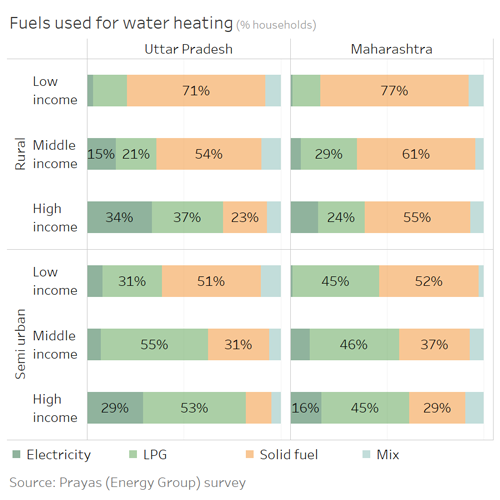Prayas (Energy Group) conducted a survey of 3000 households in semi-urban and rural areas of Uttar Pradesh and Maharashtra to understand their energy end-use patterns. This survey was conducted in February-March 2019. ECHO is a series of blog posts presenting the key findings of the survey. This post discusses households’ use of energy for water heating.
Sampling plan and household categorization are briefly described here.
Water heating for bathing is an overlooked end-use in India in the current policy context. Interventions aimed at eliminating the use of solid fuels have focused primarily on its use for cooking. Solar water heaters received significant policy attention in past but a national programme subsidizing solar water heaters was discontinued in 2014. Bureau of Energy Efficiency (BEE), on the other hand, does have a mandatory standards and labeling (S&L) programme for storage type electric water heaters. In this post, we discuss the usage patterns for water heating in the surveyed households and how they can inform policy interventions focusing on the same.
Winters are usually colder in Uttar Pradesh than in Maharashtra. However, only 34% of the surveyed households in Uttar Pradesh use hot water for bathing compared to 92% in Maharashtra. Furthermore, households in Uttar Pradesh which use hot water for bathing do so only for 2 months on average as compared to 6 months in Maharashtra. Several factors may be behind the low use of hot water for bathing in Uttar Pradesh. Income is possibly one of the reasons, with the share of households using hot water for bathing increasing from about 25% in low income households to about 50% in high income households. Social practices may also play its part. Anecdotal evidence suggest that people use warm groundwater for bathing in winters. However, there is a possibility that as incomes rise and social practices change, there is a rise in use of energy for heating water. This needs to be examined further.
Households that already use hot water for bathing use different fuels. Use of solid fuels is quite common in both states (see Figure 1). About 35% of the surveyed households using hot water in Uttar Pradesh and 52% in Maharashtra use solid fuels. Interestingly, about 37% of these households in Uttar Pradesh and 91% in Maharashtra using solid fuels for heating water use LPG for most of their cooking. This suggests the need for carefully designed interventions to move people away from using solid fuels for water heating. Use of solid fuel boilers or open air chulhas placed in courtyards is quite common in households in Maharashtra. This may not result in indoor household pollution but can contribute to the local air-pollution. LPG is the next commonly used fuel for water heating, particularly in semi-urban areas. About 39% of the surveyed households using hot water in Uttar Pradesh and 33% in Maharashtra use LPG for heating water. Households using LPG for water heating typically use 2 cylinders more than those who do not in Uttar Pradesh and 0.7 in Maharashtra. Only about 19% in Uttar Pradesh and 7% in Maharashtra use an LPG instant water-heater. Others use an LPG stove which most probably is the same on which the food is cooked.

Figure 1: Fuels used for water heating in surveyed households
Few households use electricity for water heating, about 19% of the households using hot water in Uttar Pradesh and 8% in Maharashtra. About 92% of the households in Uttar Pradesh and 82% in Maharashtra using electricity for water heating use immersion rod which is prone to electric shocks and fire accidents. Use of solar water heaters is almost negligible in both states. Households do not switch between fuels for water heating like they do for cooking.
Water heating, if used, contributes significantly to the total household energy consumption. The common use of solid fuels can result in indoor as well as local air-pollution with consequent adverse health impacts. Interventions focused on eliminating the use of solid fuels for cooking may not work for water heating. A careful evaluation of alternatives like electricity, LPG, or solar water heaters is needed before designing interventions to push for their adoption.
This concludes our blog posts on individual energy end-uses. In the next blog post, we will conclude the blog series by summarising the insights from our survey and estimation of the contribution of each end-use to the total household energy consumption.
Please contact Aditya Chunekar (
This post was translated and published by Eklavya in their Hindi magazine Srot (Vigyan evam technology features). This translation is available here.


